西安概况英文介绍
西安英文介绍
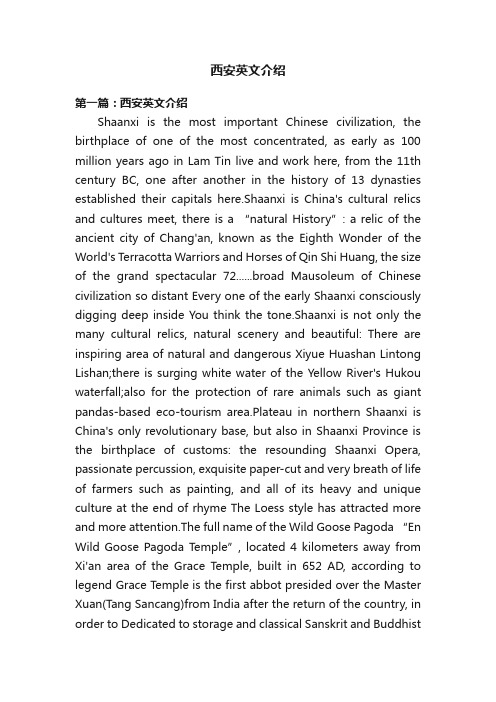
西安英文介绍第一篇:西安英文介绍Shaanxi is the most important Chinese civilization, the birthplace of one of the most concentrated, as early as 100 million years ago in Lam Tin live and work here, from the 11th century BC, one after another in the history of 13 dynasties established their capitals here.Shaanxi is China's cultural relics and cultures meet, there is a “natural History”: a relic of the ancient city of Chang'an, known as the Eighth Wonder of the World's Terracotta Warriors and Horses of Qin Shi Huang, the size of the grand spectacular 72......broad Mausoleum of Chinese civilization so distant Every one of the early Shaanxi consciously digging deep inside You think the tone.Shaanxi is not only the many cultural relics, natural scenery and beautiful: There are inspiring area of natural and dangerous Xiyue Huashan Lintong Lishan;there is surging white water of the Yellow River's Hukou waterfall;also for the protection of rare animals such as giant pandas-based eco-tourism area.Plateau in northern Shaanxi is China's only revolutionary base, but also in Shaanxi Province is the birthplace of customs: the resounding Shaanxi Opera, passionate percussion, exquisite paper-cut and very breath of life of farmers such as painting, and all of its heavy and unique culture at the end of rhyme The Loess style has attracted more and more attention.The full name of the Wild Goose Pagoda “En Wild Goose Pagoda Temple”, located 4 kilometers away from Xi'an area of the Grace Temple, built in 652 AD, according to legend Grace Temple is the first abbot presided over the Master Xuan(Tang Sancang)from India after the return of the country, in order to Dedicated to storage and classical Sanskrit and Buddhistrelics and other objects Duzao personally designed and built.Huaqing Pool is located in Xi'an Lintong district on the north side of Lishan, 30 km east of Xi'an.Huaqing Pool because of the emperor and Yang legend and reputation spread far and wide, in fact, the Huaqing Pool is a long history, legend, in the early Western Zhou Dynasty, Zhou You Wang Jian Li was in the palace;generations of the First Qin Emperor, Emperor also set up here Palace;more large-scale construction of the Tang Dynasty, in particular the emperor Tianbao years to build a more luxurious palace pavilion, and changed its name to the official “China Palace.”Terracotta warriors and horses is the only imperial tombs from the mass grave, located on the eastern side of Qin Shi Huang Mausoleum of about 1 kilometer and a half, was found in 1974, is the most important archaeological discoveries of.One pit was discovered when local farmers digging, drilling after another has found that two pit on the 3rd, one of which pits the largest, covering an area of 14,260 square meters.A total of three pits excavated more than 700 pieces of pottery figurine, by more than 100 tanks, more than 400 horses Ma Tao, more than 100,000 pieces of weapons.Pottery figurine at the height of 1 meter 75-1 m 85, according to dress, look, the style, can be divided into general figurines, warrior figurines, figurines, and other vehicles with disabilities.There are also excavated pit sword, spear, halberd, bronze weapons such as machetes, although buried in the soil in more than two thousand years, the blade is still sharp, sparkling, can be seen as a miracle in the history of metallurgy in the world.Terracotta Warriors and Horses of Qin Shi Huang large-scale, powerful scenes, with high artistic value.Clock Tower is located in Xi'an city of the North and the South East and WestMain Street, four of the interchange.Ming Hongwu 17 years before, the site of the Xi'an Guangji in this corner, Wanli next 10 years to move the site of the Qing Emperor Qianlong had five-year renovation.Bronze bell hanging on the clock tower to time, the clock tower named.Drum T ower in Xi'an is located in North and West Main Street Interchange house, the Clock Tower in the east every other across the square, the Drum Tower Ming Hongwu 13 years, twice rebuilt in the Qing Dynasty.The original one upstairs giant drum, drumming in the evening time, the Drum Tower named.陕西是华夏文明最重要、最集中的发源地之一,早在100万年前就有蓝田人在此生息劳作,从公元前11世纪起,历史上先后有13个朝代在此建都。
中国古都西安英文介绍(共30张PPT)
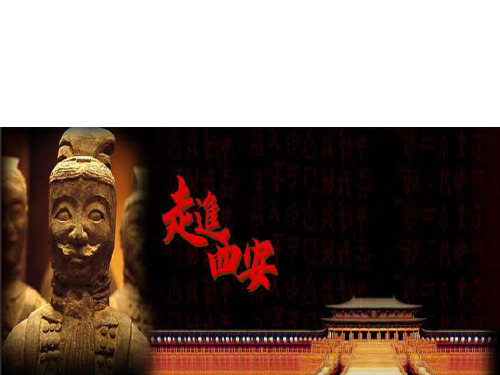
Noodle with pork
cruded pancake in mutton soup Parsley
The Terra Cotta Warriors And horses
The Terra Cotta Warriors And horses is regarded as one of the eight greatest wonders in the world,and a sight not to be missed by any visitor to China.In 1987,it was listed as one of the world cultural heritages by UNESCO.As one of the most famous scenic spots in China,it attracts lots of tourists both at home and from abroad.The museum covers an area of 16,300 square meters,and is divided into three sections:No.1 Pit (坑 ),No.2 Pit,No.3 Pit respectively.They were tagged in the order of their discoveries.There are columns(塔器)of soldiers at the front,followed by war chariots(战车) at the back.
The city wall
The main magnet of Xian is the city wall, which is the most complete city wall that has survived in China as well being one of the largest ancient military defensive systems in the world. It was enlarged in Ming Dynasty (1368-1644) from the city wall initially built in Tang Dynasty (618 -907). Now it is 12 meters tall, 12-14 meters wide overing 14 kilometers in length with a deep moat surrounding it. You can walk, even cycle on the wall. Its south gate is the most largest with a suspension bridge. Most of the tourists choose the south gate for sightseeing.
西安简介英语带翻译
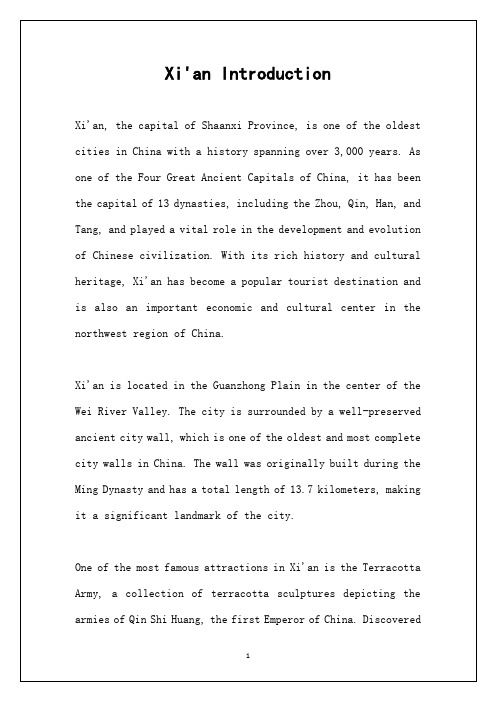
Xi'an is located in the Guanzhong Plain in the center of the Wei River Valley. The city is surrounded by a well-preserved ancient city wall, which is one of the oldest and most complete city walls in China. The wall was originally built during the Ming Dynasty and has a total length of 13.7 kilometers, making it a significant landmark of the city.
In recent years, Xi'an has also been actively promoting the development of its high-tech industry, with a focus on information technology, aerospace, and new energy. As a result, the city has attracted a large number of talented professionals and entrepreneurs, as well as significant investment from both domestic and international companies.
西安简介英文和中文简短

西安简介英文和中文简短1.英文版的西安简介3.西安英文简介7.英语作文:介绍西安的历史文化古迹,要求简单通俗易懂As one of the oldest cities in Chinese history,Xi'an is one of the Four Great Ancient Capitals of China because it has been the capital of some of the most important dynasties in Chinese history,including the Zhou,Qin,Han,the Sui,and Tang dynasties.Xi'an is the eastern end of the Silk Road .The city has more than 3,100 years of history 8.以介绍西安写一篇英文开场白My hometown in XiAn. Sand everywhere there before, very desolate.Traffic blocking。
Now ,the railway connecting the capital,there is very beautiful. In the middle of the village there is a small river before. Middle Creek has a pond with lotus in full bloom, there are many fish enjoy swimming in. Planted with almond trees around the village, a tree covered with sweet fruit. In front of every house loaded with beautiful flowers. Happy people live here.。
西安及景点介绍:中英文对照(权威发布)

Introduction of Xi’anXi’an CityXi’an (Chinese: 西安), is the capital of Shaanxi Province, People’s Republic of China。
It is located in the center of the Guanzhong Plain in Northwestern China. One of the oldest cities in China, Xi'an is the oldest of the Four Great Ancient Capitals, having held the position under several of the most important dynasties in Chinese history, including Western Zhou, Qin, Western Han, Sui, and Tang. Xi’an is the starting point of the Silk Road and home to the Terracotta A rmy of Emperor Qin Shi Huang.西安,是陕西省的省会,中国人民共和国。
它位于关中平原的中心在中国西北。
中国最古老的城市之一,西安是最古老的四大古都,是多个历史上最重要的朝代的首都,包括西周、秦、西汉、隋、唐.西安是丝绸之路的起点,皇帝秦始皇的兵马俑。
Since the 1990s,as part of the economic revival of inland China especially for the central and northwest regions, the city of Xi’an has re—emerged as an important cultural, industrial and educational center of the central—northwest region, with facilities for research and development, national security and China's space exploration program. As of 2015 Xi’an has a population of 8,705,600 。
英语小作文介绍西安60词
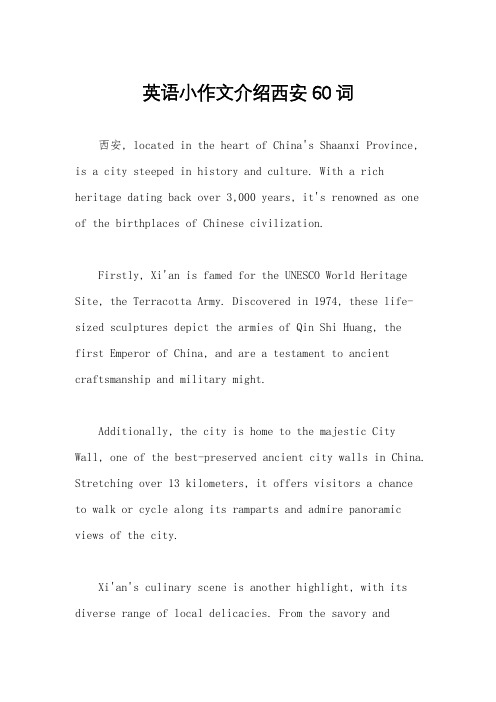
英语小作文介绍西安60词西安, located in the heart of China's Shaanxi Province, is a city steeped in history and culture. With a rich heritage dating back over 3,000 years, it's renowned as one of the birthplaces of Chinese civilization.Firstly, Xi'an is famed for the UNESCO World Heritage Site, the Terracotta Army. Discovered in 1974, these life-sized sculptures depict the armies of Qin Shi Huang, thefirst Emperor of China, and are a testament to ancient craftsmanship and military might.Additionally, the city is home to the majestic City Wall, one of the best-preserved ancient city walls in China. Stretching over 13 kilometers, it offers visitors a chanceto walk or cycle along its ramparts and admire panoramic views of the city.Xi'an's culinary scene is another highlight, with its diverse range of local delicacies. From the savory andaromatic Roujiamo (Chinese hamburger) to the flavorful Biangbiang noodles, food enthusiasts will find themselves spoiled for choice in this gastronomic paradise.Moreover, Xi'an's cultural significance extends beyond its ancient landmarks and culinary delights. It was the starting point of the Silk Road, the ancient trade route that connected China to the West, facilitating cultural exchange and economic development.In conclusion, Xi'an is a city of immense historical importance and cultural richness. Its iconic landmarks, delectable cuisine, and pivotal role in history make it a must-visit destination for travelers seeking to immerse themselves in China's vibrant past and present.。
介绍西安的英语作文(通用5篇)

介绍西安的英语作文(通用5篇)介绍西安的英语作文篇1Xi'an is the capital of Shanxi province in China and a sub-provincial city.As one of the most important cities in Chinese history,Xi'an is one of the Four Great Ancient Capitals of China for it has been the capital of 13 dynasties,including the Zhou,Qin,Han,and the Tang.Xi'an is also renowned for being the eastern terminus of the Silk Road and for the location of the Terracotta Army from Qin Dynasty.The city has more than 3,100 years of history.It was called Chang'an in ancient times.Since 1990s,as part of the economic revival of interior China,especially the central and northwest regions,in addition to a history of manufacturing and solid industrial establishments,Xi'an has become an important cultural,industrial and educational center of the central-northwest region,with facilities for research and development,national security and China's space exploration program.介绍西安的英语作文篇2Xi'an (Chinese:西安),is the capital of the Shanxi province in the People's Republic of China .As one of the oldest cities in Chinese history,Xi'an is one of the Four Great Ancient Capitals of China because it has been the capital of some of the most important dynasties in Chinese history,including the Zhou,Qin,Han,the Sui,and Tang dynasties.Xi'an is the easternendof the Silk Road .The city has more than 3,100 years of history,and was known as Chang'an (traditional Chinese:长安).Long holidays are usual during Spring Festival,Labor Holiday (1-7 May),and National Holiday (1-7 October).The number of travellers is often greater during Summer (May-August),althoughthe most pleasant season for visiting Xi'an is Autumn.介绍西安的.英语作文篇3Some of the most well-known sites in Xi'an are:The city is surrounded by a well-preserved City wall of Xi'an which was re-constructed in the 14th century during the early Ming Dynasty and was based on the inner imperial palace of Tang Dynasty.The Mausoleum of Qin Shi Huang and his Terracotta Army are located 40 km to the east of the city centre,in the city's suburbs.The Bell Tower and Drum Tower,both are located at the city's central axis.The city's Muslim quarter,which is home to the Great Mosque of Xi'an.The Giant Wild Goose Pagoda and Small Wild Goose Pagoda are both spectacular towers and both are well over 1,000 years old and have survived great earthquakes.The former is next to a large square with the largest fountain in Asia which projects water high into the air,rising and falling in time to music during one of the daily performances (usually at noon and soon after sunset).They protected Buddhist writings in the past.The Stele Forest is famous for its numerous historic inscriptions and stoneworksThe Famen Temple and its towering pagoda located on the city's outskirtXi Ming TempleWolong Temple at Kaitong laneXingjiao Temple at Shaolin Yuan (where Xuanzang's Tomb lies)Jianfu TempleBlue Dragon TempleWangji TempleThe Banpo Neolithic village is located on the outskirt of the city properThe Qianling Mausoleum,one of the many Tang Dynasty era tombs located in Xi'anThe Shaanxi History Museum has a large collection of artifacts both modern and ancient.Mount Hua is one of the most visited and steepest mountains in the countryMount Zhongnan (终南山)Mount TaibaiMount LiHuaqing Hot Springs (华清池),at the foot of Mt.Lishan,have a history of 6,000 years,the adjacent Huaqing Palace has a history of 3,000 years.Rankedamong the Hundred Famous Gardens in China,it also has the status as a National Cultural Relic Protection Unit and a National Key Scenic Area.介绍西安的英语作文篇4Xi'an was called Chang'an in Han Dynasty. The connotation of "Chang'an" is "a place of permanent peace". It was not until the prosperous Tang Dynasty that Chang'an became famous both at home and abroad as the largest and busiest international metropolis of that age in the world. Xi'an obtained its present name in 1369. It stands first on the six largest ancient capitals. From the 11 century B.C. onwards, Xi'an or its vicinity was established as the capital city by 11 dynasties successively, including the Western Zhou, the Qin, the Han, the Sui and the Tang, and it also served as the capital of two peasant regimes respectively under the rule of Huang Chao and Li Zicheng. The city's capital status lasted for 1,608 years. As regards the number of dynasties and span of time, Xi'an served as an ancient capital beyond compare.During the Tang Dynasty (618-907), Xi'an was the largest city in the world. Chang'an, was linked to many central Asian regions and Europe via the Silk Road, with thousands of foreign traders living the city.Xi'an is the capital of Shaanxi Province and also the political, economic and cultural center of the Northwest China. With the development of travel industry and the implementation of the open policy, it has become one of the nation's key tourist cities and tourism has become the mainstay in Shaanxi's economy.Xi'an lies at longitude 103? east by latitude 34?north, and 412 meters above sea level. It has an average annual temperature of 13癈, and an average annual precipitation of 604 mm. Therainy season comes in July, August and September. The city now has under its jurisdiction eight districts -- Xincheng, Beilin, Lianhu, Yanta, Weiyang, Baqiao, Lintong and Yangling, and five counties -- Chang'an, Lantian, Huxian, Zhouzhi and Gaoling. As a whole, Xi'an covers an area of 9,983 square kilometers and has population of 5,860,000. The city proper occupies an area 861 square kilometers, and reaches a population of 2,650,000.With an elevation of 500 metres, the Weihe Plain extends between Baoji in the west and Tongguan in the east and borders the Qinling Mountains in the south and the Huangtu Plateau in the north. Lying in the warm zone, the plain has a temperate climate with four distinct seasons. Chequered with the Weihe, Jinghe, Luohe, and Bahe rivers as well as the Jinghui, Weihui and Luohui canals, the fertile land on the plain has easy access to irrigation facilities and an abundant yield of farm produce. Xi'an lies in the centre to the south of this plain, a favourable geographical location surrounded by water and hills.介绍西安的英语作文篇5Once known as Chang'an, Xi'an is the political, economic, cultural and transportation center of Shaanxi Province, with its jurisdiction over five counties including Chang'an County. Located in the middle of the Central Plains of the Yellow River Basin, Xi'an stands between Qinling Mountain to the north and the Weihe River to the south. It is an important birthplace of the Chinese nationality as well as one of the places of human origin and prehistoric cultural centers in Asia. Its long history and rich cultural heritage has covered the old city with a mysterious veil.As a world-famous ancient capital, Xi'an has been designated as the capital of 13 ancient Chinese dynasties such as the Western Zhou, Qin, Xihan, Xinmang, Eastern Han, Western Jin, FormerZhao, pre-Qin, post-Qin, Western Wei, Northern Zhou, Sui and Tang dynasties. Many important historical events took place here, such as the Red Eyebrow Peasant Rebellion at the end of the Western Han Dynasty (206BC-8AD), the Huangchao Peasant Rebellion at the end of the Tang Dynasty (618-907) and Li Zicheng Peasant Rebellion at the end of the Ming Dynasty (1368-1644) all once established temporary political powers in Xi'an. it also witnessed the famous Xi'an Incident in modern history. All these have left with Xi'an a lot of cultural relics. In Xi'an there are altogether 314 key cultural relics sites under protection, of which 84 belong to state or provincial level. Unearthed cultural relics reach 120,000, many of which are rare treasures in the world, including the Stele Forest, the two Wild Goose Pagodas, the Clock Tower, the remains of Banpo Village and the city wall of the Ming Dynasty. In addition, there are ancient sites such as Han City, Tang City, Efang Palace, Weiyang Palace and Daming Palace, as well as the Huaqing Pond and pits of Qin Emperor Shihuang's Terra-Cotta Soldiers and Horses. Xi'an is a great place of revolution, and the Site of the Office of the Eighth Route Army can clearly demonstrate this. Located in Xi'an are also a number of universities and research institutions, including Xi'an Jiaotong University, Northwest University and Northwest Polytechnical University.Xi'an is the biggest processing industrial base and the largest trade center in the central and western part of North China, as well as the starting point of the Silk Road. The Silk Road has become a wide road connecting China and other countries. It is a road to civilization, friendship, trade and cultural tourism.Xi'an (Chinese: 西安), is the capital of the Shanxi province in the People's Republic of China . As one of the oldest cities inChinese history, Xi'an is one of the Four Great Ancient Capitals of China because it has been the capital of some of the most important dynasties in Chinese history,including the Zhou, Qin, Han, the Sui, and T ang dynasties. Xi'an is the eastern end of the Silk Road . The city has more than 3,100 years of history, and was known as Chang'an (traditional Chinese: 长安).Long holidays are usual during Spring Festival, Labor Holiday (1-7 May), and National Holiday (1-7 October). The number of travellers is often greater during Summer (May-August), although the most pleasant season for visiting Xi'an is Autumn.Xi'an (Chinese: 西安), is the capital of the Shanxi province in the People's Republic of China . As one of the oldest cities in Chinese history, Xi'an is one of the Four Great Ancient Capitals of China because it has been the capital of some of the most important dynasties in Chinese history,including the Zhou, Qin, Han, the Sui, and T ang dynasties. Xi'an is the eastern end of the Silk Road . The city has more than 3,100 years of history, and was known as Chang'an (traditional Chinese: 长安).Long holidays are usual during Spring Festival, Labor Holiday (1-7 May), and National Holiday (1-7 October). The number of travellers is often greater during Summer (May-August), although the most pleasant season for visiting Xi'an is Autumn.。
Xi'an introduce西安介绍英文
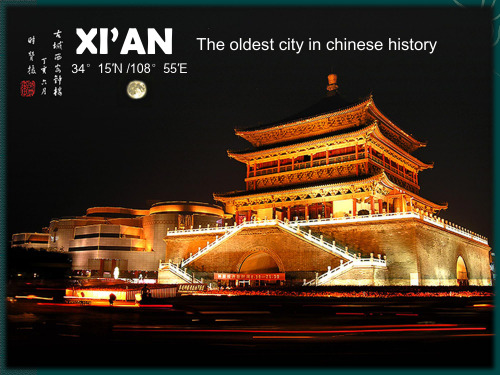
Mount Hua
Mount Hua is one of the famous mountains in China, is located in shaanxi province HuaYinXian, in 120 kilometres east of xi 'an, is famous for its mountain steep.
西安,古称长安,是举世闻名的世界四大文明古都之一。历史上包括 西汉、唐在内的总共13个王朝都曾在此建都。西安曾经作为中国的首都 和政治、经济、文化中心长达1000多年,与洛阳、北京、南京并称为中 国四大古都。
The Terra Cotta Warriors
Terracotta Warriors Museum is located away from Xi'an Lintong, 37 kilometers east of county Terracotta Warriors, is the world's largest underground military museum.
security
Xi 'an is a relatively safe city,. But more is the thief.
西安是一个比较安全的城市。 但就是小偷比较多。
Climate
Xi „an is a warm temperate semi-humid continental monsoon climate, four seasons, mild climate, moderate rainfall. The spring warmth; Summer heat; Autumn is cool; The winter cold.
介绍西安的英语作文60词六年级

介绍西安的英语作文60词六年级示例回答如下1:Introduction to Xi'anXi'an is a city located in the Shaanxi province of China. It is known for its rich history and cultural heritage. With a population of over 8 million people, Xi'an is one of the oldest cities in China and has served as the capital for numerous dynasties.西安是中国陕西省的一个城市。
它以丰富的历史和文化遗产而闻名。
西安有800多万人口,是中国最古老的城市之一,曾经是许多朝代的首都。
One of the most famous attractions in Xi'an is the Terracotta Army. Discovered in 1974, the Terracotta Army is a collection of life-sized statues of soldiers, horses, and chariots that were buried with the first emperor of China, Qin Shi Huang. This archaeological site is a UNESCO World Heritage site and attracts millions of tourists each year.西安最著名的景点之一是兵马俑。
兵马俑于1974年被发现,是一组与中国第一位皇帝秦始皇一起埋葬的士兵、马匹和战车的真人大小的雕像。
这个考古遗址是联合国教科文组织世界遗产,每年吸引数百万游客。
西安简介概括英文作文
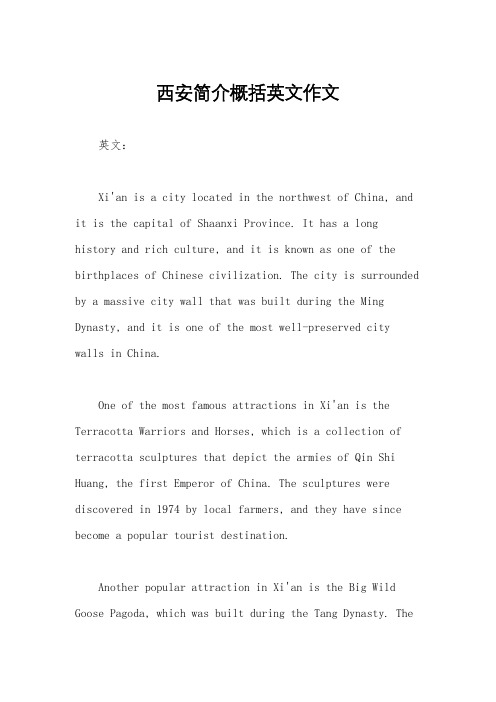
西安简介概括英文作文英文:Xi'an is a city located in the northwest of China, and it is the capital of Shaanxi Province. It has a longhistory and rich culture, and it is known as one of the birthplaces of Chinese civilization. The city is surrounded by a massive city wall that was built during the Ming Dynasty, and it is one of the most well-preserved city walls in China.One of the most famous attractions in Xi'an is the Terracotta Warriors and Horses, which is a collection of terracotta sculptures that depict the armies of Qin Shi Huang, the first Emperor of China. The sculptures were discovered in 1974 by local farmers, and they have since become a popular tourist destination.Another popular attraction in Xi'an is the Big Wild Goose Pagoda, which was built during the Tang Dynasty. Thepagoda is a Buddhist temple that houses a collection of Buddhist scriptures, and it is a symbol of the city's rich history and culture.In addition to its historical and cultural attractions, Xi'an is also known for its delicious food. One of the most famous dishes in Xi'an is the roujiamo, which is a type of Chinese sandwich made with meat and bread. Another popular dish is the biangbiang noodles, which are thick and chewy noodles that are typically served with a spicy sauce.中文:西安是中国西北地区的一个城市,是陕西省的省会。
对西安用英语的简单介绍
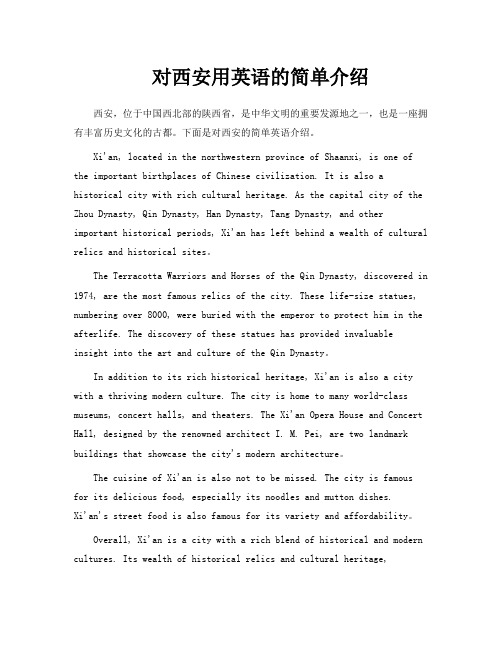
对西安用英语的简单介绍西安,位于中国西北部的陕西省,是中华文明的重要发源地之一,也是一座拥有丰富历史文化的古都。
下面是对西安的简单英语介绍。
Xi'an, located in the northwestern province of Shaanxi, is one of the important birthplaces of Chinese civilization. It is also ahistorical city with rich cultural heritage. As the capital city of the Zhou Dynasty, Qin Dynasty, Han Dynasty, Tang Dynasty, and other important historical periods, Xi'an has left behind a wealth of cultural relics and historical sites。
The Terracotta Warriors and Horses of the Qin Dynasty, discovered in 1974, are the most famous relics of the city. These life-size statues, numbering over 8000, were buried with the emperor to protect him in the afterlife. The discovery of these statues has provided invaluableinsight into the art and culture of the Qin Dynasty。
In addition to its rich historical heritage, Xi'an is also a city with a thriving modern culture. The city is home to many world-class museums, concert halls, and theaters. The Xi'an Opera House and Concert Hall, designed by the renowned architect I. M. Pei, are two landmark buildings that showcase the city's modern architecture。
介绍西安的英语优秀作文通用32篇

介绍西安的英语优秀作文通用32篇Introduction to Xi'anXi'an, known as Chang'an in ancient times, is one of the oldest cities in China with a history of over 3,000 years. It is the capital city of Shaanxi Province and is famous for being the starting point of the Silk Road. Xi'an is a city rich in history, culture, and tradition, making it a popular destination for tourists from all over the world.One of the most well-known attractions in Xi'an is the Terracotta Army, which was discovered in 1974 by a group of farmers. The Terracotta Army is a collection of terracotta sculptures depicting the armies of Qin Shi Huang, the first Emperor of China. The sculptures are incredibly detailed and each one is unique, making it a must-see for anyone visitingXi'an.Another famous attraction in Xi'an is the city walls, which were built during the Ming Dynasty. The walls are over 600 years old and are the most complete city walls in China. Visitors can walk or cycle along the walls and enjoy panoramic views of the city.Xi'an is also home to the Big Wild Goose Pagoda, a Buddhist pagoda that was built in the 7th century. The pagoda is a symbol of the city and is a popular spot for both tourists and locals.In addition to its historical attractions, Xi'an is also known for its delicious cuisine. The city is famous for its dumplings, known as "jiaozi", which are a popular street food in Xi'an. Other local specialties include biangbiang noodles, roujiamo (Chinese hamburger), and pita bread soaked in lamb soup.Overall, Xi'an is a city that beautifully combines ancient history with modern development. It is a city that has preserved its cultural heritage while embracing the benefits of globalization. Whether you are interested in history, culture, or food, Xi'an has something to offer for everyone. Come and visit Xi'an to experience the magic of this ancient city for yourself!。
西安介绍中英版

用英文介绍西安转更新汉语翻译版!Xi'an, the eternal city, records the great changes of the Chinese nation just like a living history book.Called Chang'an in ancient times, Xian is one of the birthplaces of the ancient civiliz ation in the YellowRiver Basin area of the country. During Xian's 3,100 year develop ment, 13 dynasties such as Western Zhou (11th century BC - 771 BC), Qin (221 B C - 206 BC), Western Han (206 BC - 24 AD) and Tang (618 - 907) placed their ca pitals here. So far, Xian enjoys equal fame with Athens, Cairo, and Rome as one of the four major ancient civilization capitals.Xi'an is the capital of Shaanxi province, located in the southern part of the Gua nzhong Plain. With the Qinling Mountains to the south and the Weihe River to the north, it is in a favorable geographical location surrounded by water and hills. It ha s a semi-moist monsoon climate and there is a clear distinction between the four s easons. Except the colder winter, any season is relatively suitable for traveling.The cultural and historical significance of the area, as well as the abundant relics and sites, help Xi'an enjoy the laudatory title of 'Natural History Museum'. The Mus eum of Terra Cotta Warriors and Horses is praised as 'the eighth major miracle of t he world', Mausoleum of Emperor Qin Shi Huang is listed on the World Heritage Lis t, and the City Wall of the Ming Dynasty (1368 - 1644) is the largest and most int act Ming Dynasty castle in the world. In the city, there is the 3,000 year old Banpo Village Remains from the Neolithic Age (approximately from 8000 BC to 5000 BC), and the Forest of Stone Steles that holds 3,000 stone steles of different periods fro m the Han Dynasty to the Qing Dynasty.Around Xi'an, the Famen Temple enjoys the reputation of being the 'forefather o f pagodas and temples in Central Shaanxi,' because it holds the finger bones of Sak yamuni -- the founder of Buddhism. The natural landscape around Xian is also marv elous Mt.Huashan one of the five best-known mountains in China, is famous for its breath-taking cliffs and its unique characteristics.Traditional downtown Xi'an refers to the area encircled by the city wall, this has now been expanded to encompass the area within the second ring road (Er' huan Lu). The Bell Tower is the geographical center of Xi'an and the four main streets ar e respectively Dong Dajie, Xi Dajie, Nan Dajie and Bei Dajie which are also the mai n commercial streets. Xiao Zhai, the busiest commercial area is in the southern part of the city and is popular with both youths and students since many universities a re located here. Shuyuan Men and the still under construction Luoma Shi are must-visit pedestrian streets in the city. Xian is also famous for its quantity of colleges th roughout China. The old campuses of many colleges and universities are massed in the southern suburb of Xi'an, but most have established new campuses in far south ern suburb - Chang'an District due to the lack of space within the city.As tourist development grows in Xi'an, the hotel industry flourishes more and mor e. It is very easy to find a hotel in Xian, ranging from 5 star hotels to youth hoste ls. Of course, it will be any traveler's first choice to stay in the city center due to t he superior geographical location and the convenient transportation.Praised as 'the capital of table delicacies', Xi'an has been rich in the delicious Sh aanxi snack, delicate Guangdong Cuisine, various kinds of fashionable foreign delicac ies, and popular Sichuan Cuisine such as the hot pot. Among all the delicacies, the most famous and popular one is the Muslim Snack Street.Xi'an is the most important city in northwest China, and so there are a lot of sh opping outlets for locals and tourists alike. There are many big shopping centers, d epartment stores and supermarkets in and around Xian city - the biggest and most comprehensive being Kai Yuan Shopping Mall and Century Ginwa Shopping Mall.The night life in Xi'an has a unique glamour. Traditional ways include enjoying t he night scenery around the Bell Tower, taking part in a Tang Dynasty Dinner Sho w, strolling on the ancient Big Wild Goose Pagoda Square and watching the music f ountain performance. More modern and fashionable ways include singing in the KTV, hanging out in a bar, or dancing in a Disco. All in all, any experience in this ancie nt city will bring you fun and possibly a little surprise!更新汉语版:西安,这座不朽的城市,如同一部鲜活的历史书,记录着中华民族的变迁。
西安英语介绍作文80词

西安英语介绍作文80词Xi'an, a city with a history dating back thousands of years, is locatedin the heart of China. 西安是一座历史悠久的城市,可以追溯到数千年前,位于中国的中心地带。
It is known as one of the Four Great Ancient Capitals of China, along with Beijing, Nanjing, and Luoyang. 它被誉为中国四大古都之一,与北京、南京和洛阳齐名。
One of the most famous attractions in Xi'an is the Terracotta Army, a collection of life-sized sculptures depicting the armies of Qin Shi Huang, the first Emperor of China. 西安最著名的景点之一是秦始皇兵马俑,这是一组栩栩如生的雕塑,描绘了中国第一位皇帝秦始皇的军队。
The city's ancient city walls, which were built during the Ming Dynasty, offer a stunning panoramic view of Xi'an. 该市的古城墙建于明朝,提供了西安的壮丽全景。
In addition to its historical attractions, Xi'an is also known for its delicious food, including famous dishes such as biang biang noodlesand roujiamo (Chinese hamburger). 除了历史景点外,西安还以美食而闻名,包括著名的沉饶沉饶面和肉夹馍(中国汉堡)。
中国古都西安英文介绍(共30张PPT)

Steamed dumplings
Noodle with pork
cruded pancake in mutton soup Parsley
The Terra Cotta Warriors And horses
The Terra Cotta Warriors And horses is regarded as one of the eight greatest wonders in the world,and a sight not to be missed by any visitor to China.In 1987,it was listed as one of the world cultural heritages by UNESCO.As one of the most famous scenic spots in China,it attracts lots of tourists both at home and from abroad.The museum covers an area of 16,300 square meters,and is divided into three sections:No.1 Pit (坑 ),No.2 Pit,No.3 Pit respectively.They were tagged in the order of their discoveries.There are columns(塔器)of soldiers at the front,followed by war chariots(战车) at the back.
kilometers east of Xi'an, about 3 hours from the city centre. There are five peaks that make up the mountain: Cloud Terrace Peak (North Peak, 1613m)(北云台峰 ), Jade Maiden Peak (Middle Peak, 2042m)(中玉女 峰 ), Sunrise Peak (East Peak, 2100m)(东朝 阳峰 ), Lotus Peak (West Peak, 2038m) (西 莲花峰 )and Landing
西安介绍英文作文格式范文
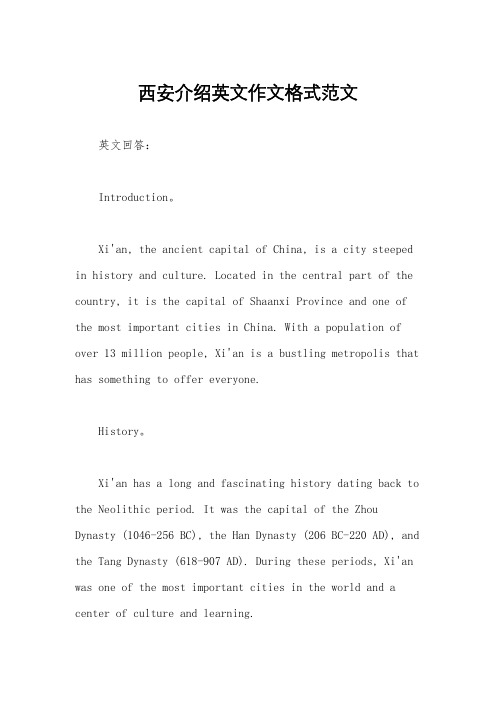
西安介绍英文作文格式范文英文回答:Introduction。
Xi'an, the ancient capital of China, is a city steeped in history and culture. Located in the central part of the country, it is the capital of Shaanxi Province and one of the most important cities in China. With a population of over 13 million people, Xi'an is a bustling metropolis that has something to offer everyone.History。
Xi'an has a long and fascinating history dating back to the Neolithic period. It was the capital of the Zhou Dynasty (1046-256 BC), the Han Dynasty (206 BC-220 AD), and the Tang Dynasty (618-907 AD). During these periods, Xi'an was one of the most important cities in the world and a center of culture and learning.Culture。
Xi'an is home to a number of important cultural attractions, including the Terracotta Army, the Big Wild Goose Pagoda, and the Shaanxi History Museum. The Terracotta Army is a collection of over 8,000 terracotta warriors and horses that were buried with the first emperor of China, Qin Shi Huang. The Big Wild Goose Pagoda is a Buddhist temple that was built in the 7th century AD. The Shaanxi History Museum is home to a vast collection of artifacts from the history of Shaanxi Province.Food。
介绍西安的英语优秀作文
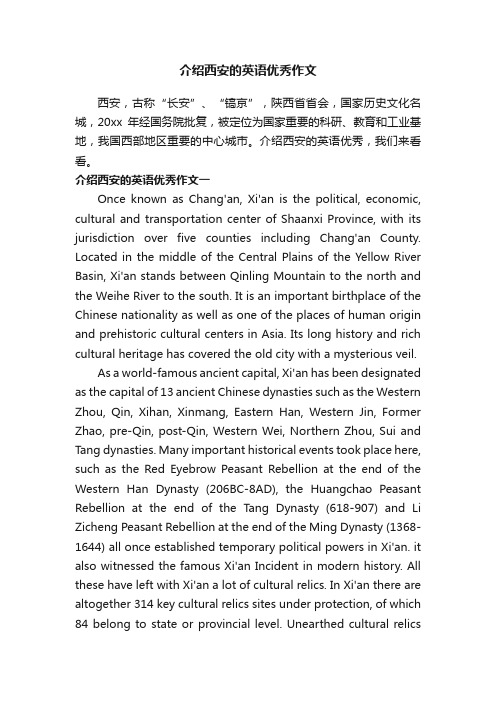
介绍西安的英语优秀作文西安,古称“长安”、“镐京”,陕西省省会,国家历史文化名城,20xx年经国务院批复,被定位为国家重要的科研、教育和工业基地,我国西部地区重要的中心城市。
介绍西安的英语优秀,我们来看看。
介绍西安的英语优秀作文一Once known as Chang'an, Xi'an is the political, economic, cultural and transportation center of Shaanxi Province, with its jurisdiction over five counties including Chang'an County. Located in the middle of the Central Plains of the Yellow River Basin, Xi'an stands between Qinling Mountain to the north and the Weihe River to the south. It is an important birthplace of the Chinese nationality as well as one of the places of human origin and prehistoric cultural centers in Asia. Its long history and rich cultural heritage has covered the old city with a mysterious veil.As a world-famous ancient capital, Xi'an has been designated as the capital of 13 ancient Chinese dynasties such as the Western Zhou, Qin, Xihan, Xinmang, Eastern Han, Western Jin, Former Zhao, pre-Qin, post-Qin, Western Wei, Northern Zhou, Sui and Tang dynasties. Many important historical events took place here, such as the Red Eyebrow Peasant Rebellion at the end of the Western Han Dynasty (206BC-8AD), the Huangchao Peasant Rebellion at the end of the Tang Dynasty (618-907) and Li Zicheng Peasant Rebellion at the end of the Ming Dynasty (1368-1644) all once established temporary political powers in Xi'an. it also witnessed the famous Xi'an Incident in modern history. All these have left with Xi'an a lot of cultural relics. In Xi'an there are altogether 314 key cultural relics sites under protection, of which 84 belong to state or provincial level. Unearthed cultural relicsreach 120,000, many of which are rare treasures in the world, including the Stele Forest, the two Wild Goose Pagodas, the Clock Tower, the remains of Banpo Village and the city wall of the Ming Dynasty. In addition, there are ancient sites such as Han City, Tang City, Efang Palace, Weiyang Palace and Daming Palace, as well as the Huaqing Pond and pits of Qin Emperor Shihuang's Terra-Cotta Soldiers and Horses. Xi'an is a great place of revolution, and the Site of the Office of the Eighth Route Army can clearly demonstrate this. Located in Xi'an are also a number of universities and research institutions, including Xi'an Jiaotong University, Northwest University and Northwest Polytechnical University.Xi'an is the biggest processing industrial base and the largest trade center in the central and western part of North China, as well as the starting point of the Silk Road. The Silk Road has become a wide road connecting China and other countries. It is a road to civilization, friendship, trade and cultural tourism.Xi'an (Chinese: 西安), is the capital of the Shanxi province in the People's Republic of China . As one of the oldest cities in Chinese history, Xi'an is one of the Four Great Ancient Capitals of China because it has been the capital of some of the most important dynasties in Chinese history,including the Zhou, Qin, Han, the Sui, and T ang dynasties. Xi'an is the eastern end of the Silk Road . The city has more than 3,100 years of history, and was known as Chang'an (traditional Chinese: 长安).Long holidays are usual during Spring Festival, Labor Holiday (1-7 May), and National Holiday (1-7 October). The number of travellers is often greater during Summer (May-August), although the most pleasant season for visiting Xi'an is Autumn.Xi'an (Chinese: 西安), is the capital of the Shanxi province inthe People's Republic of China . As one of the oldest cities in Chinese history, Xi'an is one of the Four Great Ancient Capitals of China because it has been the capital of some of the most important dynasties in Chinese history,including the Zhou, Qin, Han, the Sui, and T ang dynasties. Xi'an is the eastern end of the Silk Road . The city has more than 3,100 years of history, and was known as Chang'an (traditional Chinese: 长安).Long holidays are usual during Spring Festival, Labor Holiday (1-7 May), and National Holiday (1-7 October). The number of travellers is often greater during Summer (May-August), although the most pleasant season for visiting Xi'an is Autumn. 介绍西安的英语优秀作文二Xi'an was called Chang'an in Han Dynasty. The connotation of "Chang'an" is "a place of permanent peace". It was not until the prosperous Tang Dynasty that Chang'an became famous both at home and abroad as the largest and busiest international metropolis of that age in the world. Xi'an obtained its present name in 1369. It stands first on the six largest ancient capitals. From the 11 century B.C. onwards, Xi'an or its vicinity was established as the capital city by 11 dynasties successively, including the Western Zhou, the Qin, the Han, the Sui and the Tang, and it also served as the capital of two peasant regimes respectively under the rule of Huang Chao and Li Zicheng. The city's capital status lasted for 1,608 years. As regards the number of dynasties and span of time, Xi'an served as an ancient capital beyond compare.During the Tang Dynasty (618-907), Xi'an was the largest city in the world. Chang'an, was linked to many central Asian regions and Europe via the Silk Road, with thousands of foreign traders living the city.Xi'an is the capital of Shaanxi Province and also the political, economic and cultural center of the Northwest China. With the development of travel industry and the implementation of the open policy, it has become one of the nation's key tourist cities and tourism has become the mainstay in Shaanxi's economy.Xi'an lies at longitude 103? east by latitude 34?north, and 412 meters above sea level. It has an average annual temperature of 13癈, and an average annual precipitation of 604 mm. The rainy season comes in July, August and September. The city now has under its jurisdiction eight districts -- Xincheng, Beilin, Lianhu, Yanta, Weiyang, Baqiao, Lintong and Yangling, and five counties -- Chang'an, Lantian, Huxian, Zhouzhi and Gaoling. As a whole, Xi'an covers an area of 9,983 square kilometers and has population of 5,860,000. The city proper occupies an area 861 square kilometers, and reaches a population of 2,650,000.With an elevation of 500 metres, the Weihe Plain extends between Baoji in the west and Tongguan in the east and borders the Qinling Mountains in the south and the Huangtu Plateau in the north. Lying in the warm zone, the plain has a temperate climate with four distinct seasons. Chequered with the Weihe, Jinghe, Luohe, and Bahe rivers as well as the Jinghui, Weihui and Luohui canals, the fertile land on the plain has easy access to irrigation facilities and an abundant yield of farm produce. Xi'an lies in the centre to the south of this plain, a favourable geographical location surrounded by water and hills.。
- 1、下载文档前请自行甄别文档内容的完整性,平台不提供额外的编辑、内容补充、找答案等附加服务。
- 2、"仅部分预览"的文档,不可在线预览部分如存在完整性等问题,可反馈申请退款(可完整预览的文档不适用该条件!)。
- 3、如文档侵犯您的权益,请联系客服反馈,我们会尽快为您处理(人工客服工作时间:9:00-18:30)。
Xi'an was once called "Chang'an" in the Han Dynasty. The connotation of this name is "permanent peace".Xi'an marked the starting point of the world famous Silk Road.It obtained its present name in the year 1369. Xi'an ranks first on the list of the country's seven largest ancient capitals. From 11th centry B.C.onwards, Xi'an or its vicinity has been established as the capital city by 15 kingdoms or feudal dynasties successively, including the Western Zhou, the Qin, the Han, the Sui and the Tang. It serves as an ancient capital city beyond comparison with regard to the number of dynasties and span of time.And it was regarded as one of the "Four Ancient Civilizations of the World", the other three being Rome, Athens, and Istanbul.
Xi'an is situated in the middle of the Y ellow River reaches and at the center of the Central Shannxin Plain. Within Xi'an one can find a large number of historic attractions, such as the remains of Banpo Village,a Neolithic matriarchal clan community, the Mausoleum of the First Qin Emperor, which has been listed in "the World Cultural Heritages", the Big Wild Goose Pagoda and Small Wild Goose Pagoda built in the Tang Dynasty, the Bell Tower, Drum Tower and City Wall built in the Ming Dynasty, and the time-honored Forest of Stone Tablets. Walking around this old city is like going through thousands of years back in history. So there is no wonder why foreigners always say "He who has not visited Xi'an can not be said to have visited China."
西安古称长安,取长治久安之意。
长安是著名的丝绸之路的起点。
公元1369年,长安更名为西安。
它是我国七大古都之冠,从公元前11世纪起,先后有周秦汉隋唐等13个王朝在此建都,历时1100多年,是我国历史建都朝代最多,历时最长的都城。
它与意大利的罗马,希腊的雅典和土耳其的伊斯坦布尔并称为世界四大古都。
西安位于黄河流域中部的关中平原,在西安你会看到许多历史文化遗迹,比如新石器时代母系氏族社会的半坡遗址,被列入世界遗产名录的秦始皇陵,唐代的大小雁塔,明代的城墙,钟楼与鼓楼和有近千年历史,被称为石质书库的西安碑林等。
漫步西安,如同走进一座上下数千年的历史博物馆。
因此,外国人常说:“不到西安,不算真正到过中国”。
Local Produces 地方土特产
the Fire-crystal Persimmons 临潼火晶柿子the Glutinous Rice Wine黄桂稠酒
the Persimmon Pancakes 黄桂柿子饼the Pomegranates临潼石榴the kiwi fruit 中华猕猴桃the Dates 陕北红枣
Local Snacks地方小吃
the Cured Meat in Pancakes肉夹馍Shredded Pancakes in Mutton or Beef Broth 牛羊肉泡馍
the Buckwheat noodles荞面饸饹the Cold noodles 凉皮。
